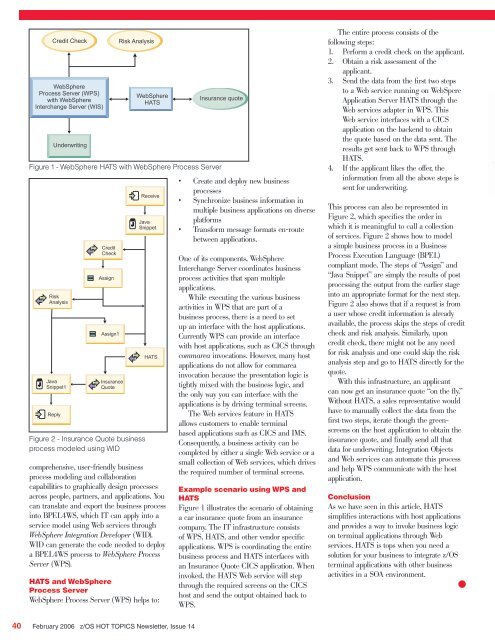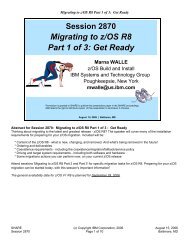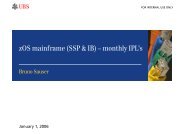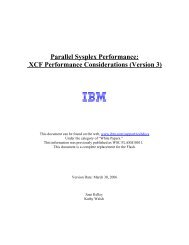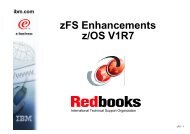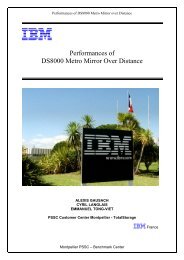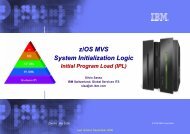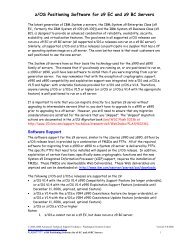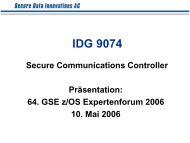Hot Topics - Messmer The Brain House
Hot Topics - Messmer The Brain House
Hot Topics - Messmer The Brain House
Create successful ePaper yourself
Turn your PDF publications into a flip-book with our unique Google optimized e-Paper software.
Credit Check Risk Analysis<br />
WebSphere<br />
Process Server (WPS)<br />
with WebSphere<br />
Interchange Server (WIS)<br />
Underwriting<br />
WebSphere<br />
HATS<br />
comprehensive, user-friendly business<br />
process modeling and collaboration<br />
capabilities to graphically design processes<br />
across people, partners, and applications. You<br />
can translate and export the business process<br />
into BPEL4WS, which IT can apply into a<br />
service model using Web services through<br />
WebSphere Integration Developer (WID).<br />
WID can generate the code needed to deploy<br />
a BPEL4WS process to WebSphere Process<br />
Server (WPS).<br />
HATS and WebSphere<br />
Process Server<br />
WebSphere Process Server (WPS) helps to:<br />
40 February 2006 z/OS HOT TOPICS Newsletter, Issue 14<br />
Insurance quote<br />
Figure 1 - WebSphere HATS with WebSphere Process Server<br />
J<br />
Risk<br />
Analysis<br />
Java<br />
Snippet1<br />
Reply<br />
Credit<br />
Check<br />
Assign<br />
Assign1<br />
Insurance<br />
Quote<br />
Figure 2 - Insurance Quote business<br />
process modeled using WID<br />
J<br />
Receive<br />
Java<br />
Snippet<br />
HATS<br />
• Create and deploy new business<br />
processes<br />
• Synchronize business information in<br />
multiple business applications on diverse<br />
platforms<br />
• Transform message formats en-route<br />
between applications.<br />
One of its components, WebSphere<br />
Interchange Server coordinates business<br />
process activities that span multiple<br />
applications.<br />
While executing the various business<br />
activities in WPS that are part of a<br />
business process, there is a need to set<br />
up an interface with the host applications.<br />
Currently WPS can provide an interface<br />
with host applications, such as CICS through<br />
commarea invocations. However, many host<br />
applications do not allow for commarea<br />
invocation because the presentation logic is<br />
tightly mixed with the business logic, and<br />
the only way you can interface with the<br />
applications is by driving terminal screens.<br />
<strong>The</strong> Web services feature in HATS<br />
allows customers to enable terminal<br />
based applications such as CICS and IMS.<br />
Consequently, a business activity can be<br />
completed by either a single Web service or a<br />
small collection of Web services, which drives<br />
the required number of terminal screens.<br />
Example scenario using WPS and<br />
HATS<br />
Figure 1 illustrates the scenario of obtaining<br />
a car insurance quote from an insurance<br />
company. <strong>The</strong> IT infrastructure consists<br />
of WPS, HATS, and other vendor specific<br />
applications. WPS is coordinating the entire<br />
business process and HATS interfaces with<br />
an Insurance Quote CICS application. When<br />
invoked, the HATS Web service will step<br />
through the required screens on the CICS<br />
host and send the output obtained back to<br />
WPS.<br />
<strong>The</strong> entire process consists of the<br />
following steps:<br />
1. Perform a credit check on the applicant.<br />
2. Obtain a risk assessment of the<br />
applicant.<br />
3. Send the data from the first two steps<br />
to a Web service running on WebSpere<br />
Application Server HATS through the<br />
Web services adapter in WPS. This<br />
Web service interfaces with a CICS<br />
application on the backend to obtain<br />
the quote based on the data sent. <strong>The</strong><br />
results get sent back to WPS through<br />
HATS.<br />
4. If the applicant likes the offer, the<br />
information from all the above steps is<br />
sent for underwriting.<br />
This process can also be represented in<br />
Figure 2, which specifies the order in<br />
which it is meaningful to call a collection<br />
of services. Figure 2 shows how to model<br />
a simple business process in a Business<br />
Process Execution Language (BPEL)<br />
compliant mode. <strong>The</strong> steps of “Assign” and<br />
“Java Snippet” are simply the results of post<br />
processing the output from the earlier stage<br />
into an appropriate format for the next step.<br />
Figure 2 also shows that if a request is from<br />
a user whose credit information is already<br />
available, the process skips the steps of credit<br />
check and risk analysis. Similarly, upon<br />
credit check, there might not be any need<br />
for risk analysis and one could skip the risk<br />
analysis step and go to HATS directly for the<br />
quote.<br />
With this infrastructure, an applicant<br />
can now get an insurance quote “on the fly.”<br />
Without HATS, a sales representative would<br />
have to manually collect the data from the<br />
first two steps, iterate though the greenscreens<br />
on the host application to obtain the<br />
insurance quote, and finally send all that<br />
data for underwriting. Integration Objects<br />
and Web services can automate this process<br />
and help WPS communicate with the host<br />
application.<br />
Conclusion<br />
As we have seen in this article, HATS<br />
simplifies interactions with host applications<br />
and provides a way to invoke business logic<br />
on terminal applications through Web<br />
services. HATS is tops when you need a<br />
solution for your business to integrate z/OS<br />
terminal applications with other business<br />
activities in a SOA environment.


